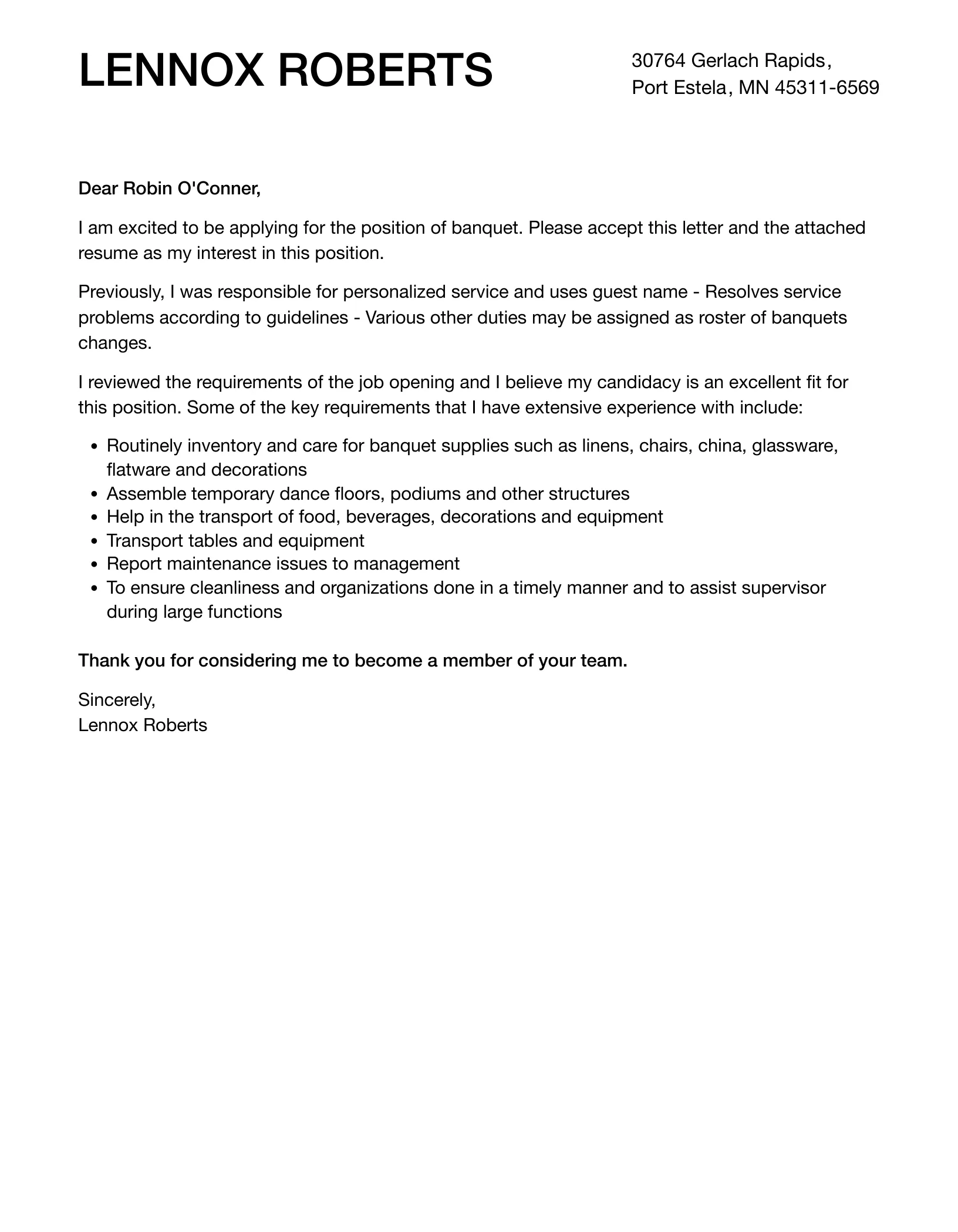What is a Banquet Manager Cover Letter
A banquet manager cover letter is a critical document that accompanies your resume when applying for a banquet manager position. It serves as your introduction to the hiring manager and provides an opportunity to showcase your qualifications, skills, and experiences in a more personalized manner than a resume. This letter allows you to highlight how your background aligns with the specific requirements of the job and to express your enthusiasm for the role and the company. A well-crafted cover letter can significantly increase your chances of securing an interview by making a compelling case for why you are the best candidate. It should be professional, concise, and tailored to each position you apply for, demonstrating your attention to detail and your understanding of the banquet manager role. The cover letter should not just repeat your resume but expand on key achievements and explain why you are a good fit for the company.
Key Components of a Strong Cover Letter
A strong cover letter consists of several key components that work together to create a persuasive argument for your candidacy. These include a professional heading with your contact information, a personalized salutation addressing the hiring manager by name whenever possible, and a concise yet engaging opening paragraph. The body of the letter should highlight your relevant skills and experience, showcasing achievements with quantifiable results whenever possible. This should be followed by a section specifically addressing the job requirements as outlined in the job description. It is vital to include a demonstration of your passion and enthusiasm for the role and the company, emphasizing your value proposition and what you bring to the table. The letter should conclude with a strong call to action, inviting the hiring manager to contact you for an interview. A well-written cover letter adheres to professional formatting and is meticulously proofread for any errors.
Contact Information
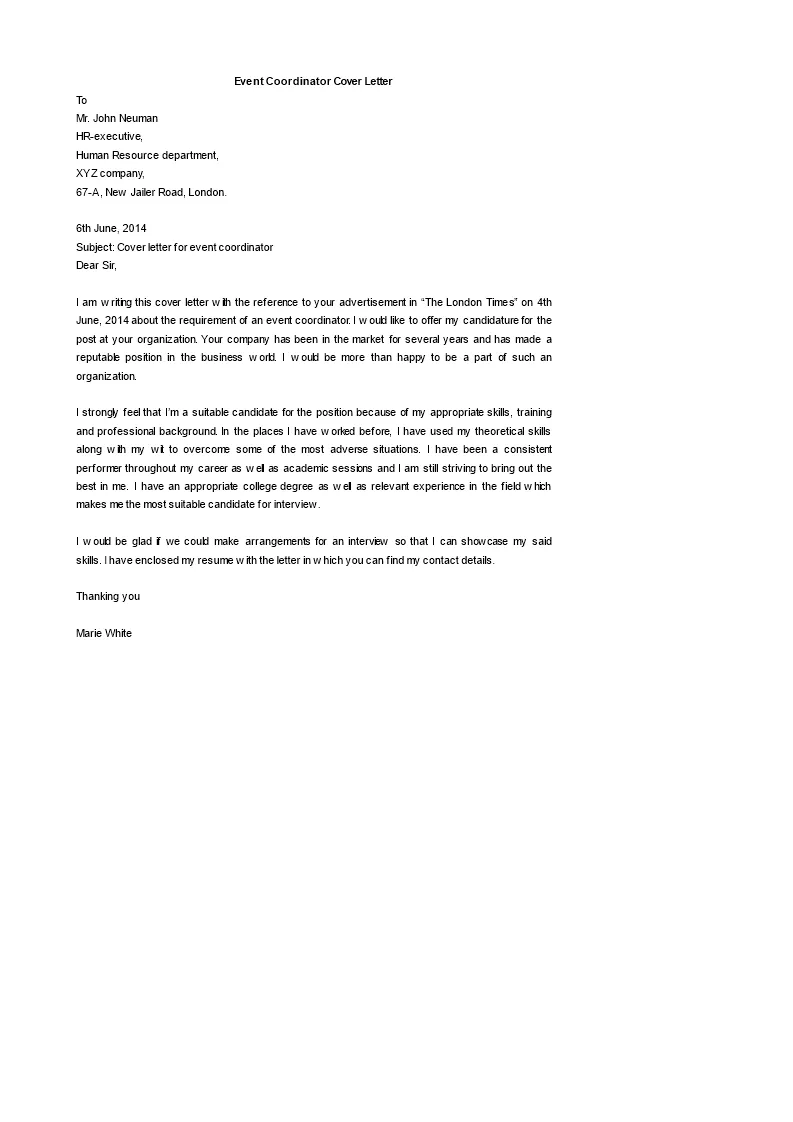
Start with your full name, address, phone number, and professional email address at the top of the cover letter. This makes it easy for the hiring manager to contact you. Ensure that your email address sounds professional. Double-check all contact information for accuracy. This section is crucial as it provides the essential details for the employer to reach you promptly and efficiently. Proper formatting and clear presentation of your contact information indicate professionalism and attention to detail, which are highly valued in a banquet manager role. Always include the date of the letter as well, placing it just beneath your contact details or the recipient’s information, creating a polished and organized appearance.
The Opening: Grabbing Their Attention
The opening paragraph is your chance to make a strong first impression. It should immediately capture the hiring manager’s attention and clearly state the position you are applying for. You can start by mentioning where you found the job posting and express your interest in the role. If you have a personal connection to the company or any relevant experience that immediately aligns with the job requirements, mention it here. Avoid generic openings like “I am writing to express my interest.” Instead, be specific and enthusiastic. For example, you might mention a specific achievement, a project you managed, or your excitement for a particular aspect of the company or the role. The goal is to create an immediate connection and encourage the reader to continue reading your cover letter. Your opening sets the tone for the rest of your letter.
Highlighting Relevant Skills and Experience
The body of your cover letter should focus on highlighting your relevant skills and experiences. Carefully review the job description and identify the key requirements. Then, provide specific examples from your professional history that demonstrate how you have successfully utilized these skills. Mention the type of events you have managed, the size of the banquets, and the number of guests you have served. If you have experience with specific software or event planning tools, be sure to mention them. You can also showcase your knowledge of food and beverage service, staff management, budgeting, and vendor negotiations. Use action verbs to describe your accomplishments and quantify your results whenever possible. Provide evidence of your achievements in the banquet industry to show your potential employer your expertise and skills.
Showcasing Achievements and Results
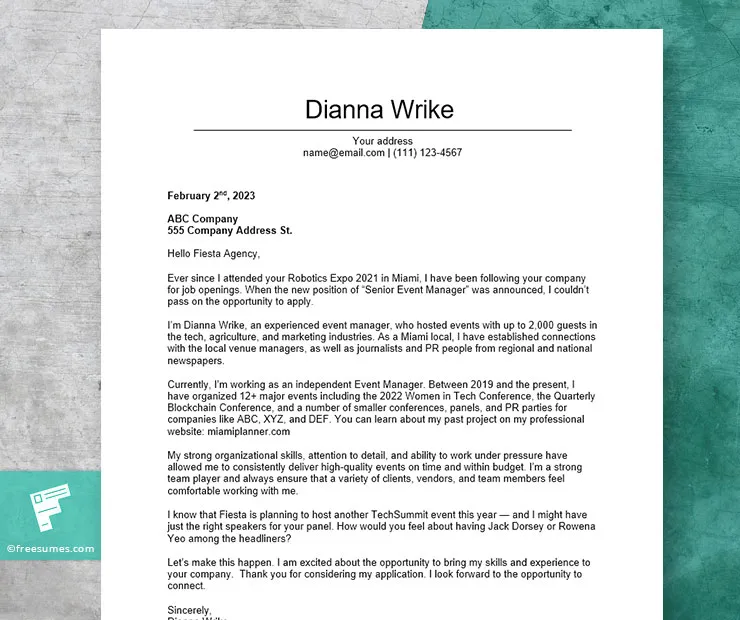
Rather than simply listing your responsibilities, focus on showcasing your achievements and the positive results you have delivered in previous roles. Use the STAR method (Situation, Task, Action, Result) to structure your responses and provide specific examples. Describe the situation or challenge you faced, the task you were assigned, the actions you took to overcome the challenge, and the results you achieved. For example, you could highlight how you improved customer satisfaction scores, reduced operational costs, or successfully managed a large-scale event. Emphasize your ability to solve problems, lead teams, and drive positive outcomes. When discussing your achievements, always consider the context of the company’s goals. Show the employer how your accomplishments align with the company’s objectives. Showing the tangible benefits of your work will significantly increase your chances of impressing a recruiter.
Quantifiable Achievements
When describing your achievements, always use quantifiable data to demonstrate your impact. Instead of saying you improved customer satisfaction, state that you increased it by 15% after implementing a new training program. Instead of saying you reduced costs, specify that you cut operational expenses by $10,000 annually. Numbers and statistics make your accomplishments more credible and give the hiring manager a clear understanding of your capabilities. Use metrics like event success rates, guest satisfaction scores, or revenue growth. Whenever possible, quantify the impact of your actions. Consider metrics that measure profitability and resource management, and consider metrics related to staff satisfaction. These types of metrics show that you are focused on achieving tangible results that benefit the company.
Addressing the Specific Job Requirements
Carefully analyze the job description and identify the key requirements the employer is looking for. Tailor your cover letter to directly address these requirements by providing specific examples of how your skills and experience align with the job. If the job description emphasizes leadership, give examples of how you have led and motivated teams. If it highlights customer service, describe your experience in exceeding guest expectations. Use the same keywords and phrases from the job description to ensure your cover letter aligns with the employer’s expectations. Be clear and concise in connecting your skills and experiences to the job requirements. This shows the hiring manager that you have carefully read the job posting and understand what the employer is looking for in a candidate. Show that you meet the expectations of the role by showcasing those relevant skills.
Demonstrating Passion and Enthusiasm
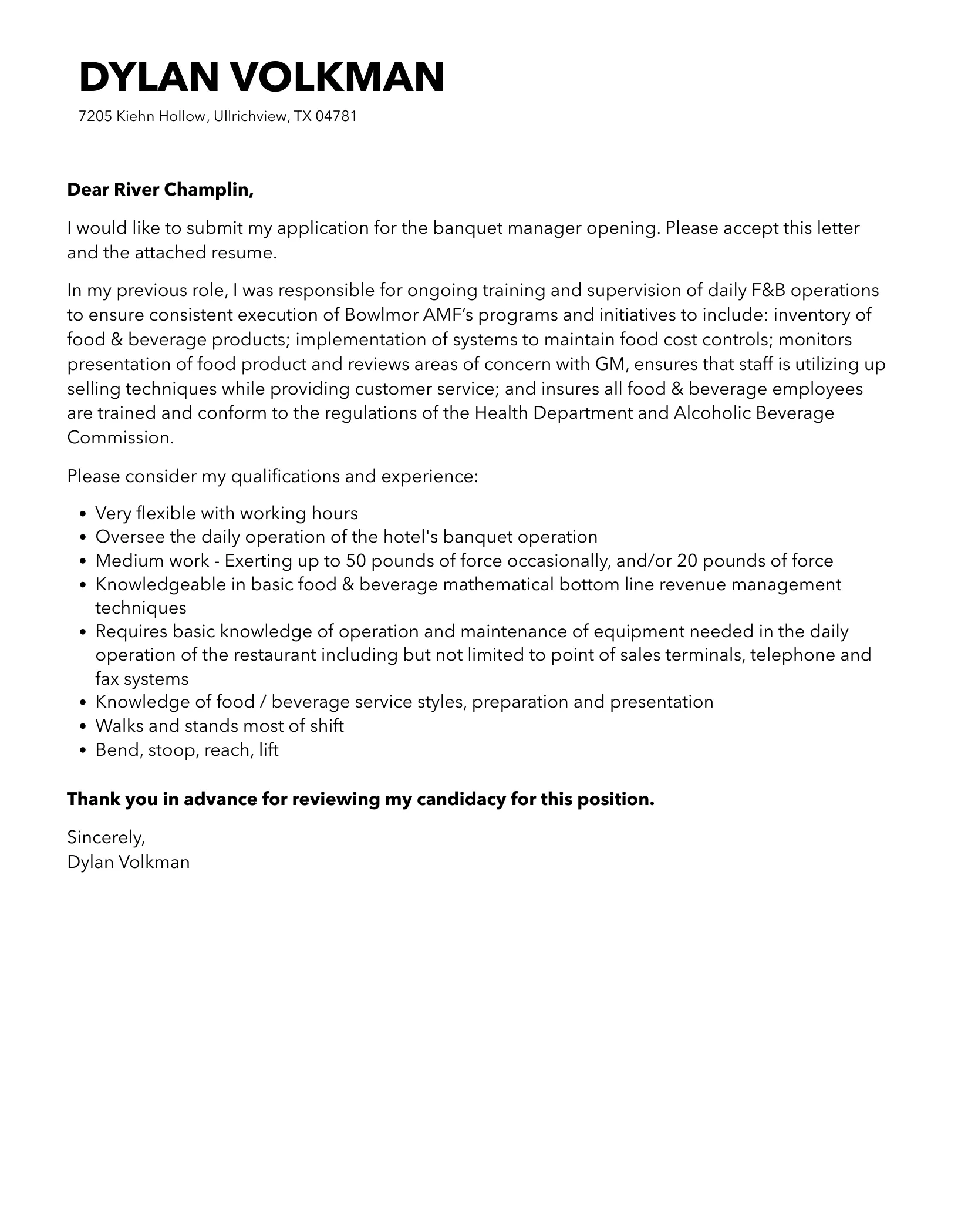
Express your passion for the banquet manager role and the hospitality industry in general. This can be done by mentioning something that excites you about the company or the specific position. Describe how you are motivated by the challenge of creating successful events. Show enthusiasm for your role. Highlight your interest in the company’s values, mission, and culture. Convey your excitement about the opportunity to contribute to their team. This could be done by mentioning your knowledge of the industry. This shows that you are enthusiastic about the opportunity and are genuinely interested in working for the company. Passion can make a significant difference. Your enthusiasm will increase your chances of standing out from other applicants. Your genuine interest in the position is likely to resonate with the hiring manager.
Expressing Your Value Proposition
Clearly articulate your value proposition – what you bring to the company. What are your unique skills, experiences, and strengths that make you the ideal candidate? Describe what sets you apart from other applicants, emphasizing how you can contribute to the company’s success. Consider how you can bring innovation. Demonstrate how you can add value in terms of event planning, team leadership, customer satisfaction, or financial performance. Your value proposition should align with the company’s goals and needs. If possible, explain how your skills can help the business, focusing on specific company objectives, and explaining the value you provide. Make sure to relate your skills to the company’s mission and values.
The Closing: Call to Action
End your cover letter with a strong call to action, inviting the hiring manager to contact you for an interview. Thank them for their time and consideration, and reiterate your enthusiasm for the opportunity. Provide your contact information again, making it easy for them to reach you. You could also state your availability for an interview and express your willingness to provide any additional information. A strong call to action demonstrates your eagerness for the position and increases the likelihood of getting a response. Consider the company’s timeline for hiring and express your availability to follow up, but always maintain a respectful and professional tone in your closing. Offer to provide references upon request, emphasizing your commitment to the position and ensuring the recruiter is aware of how to contact you.
Proofreading and Formatting
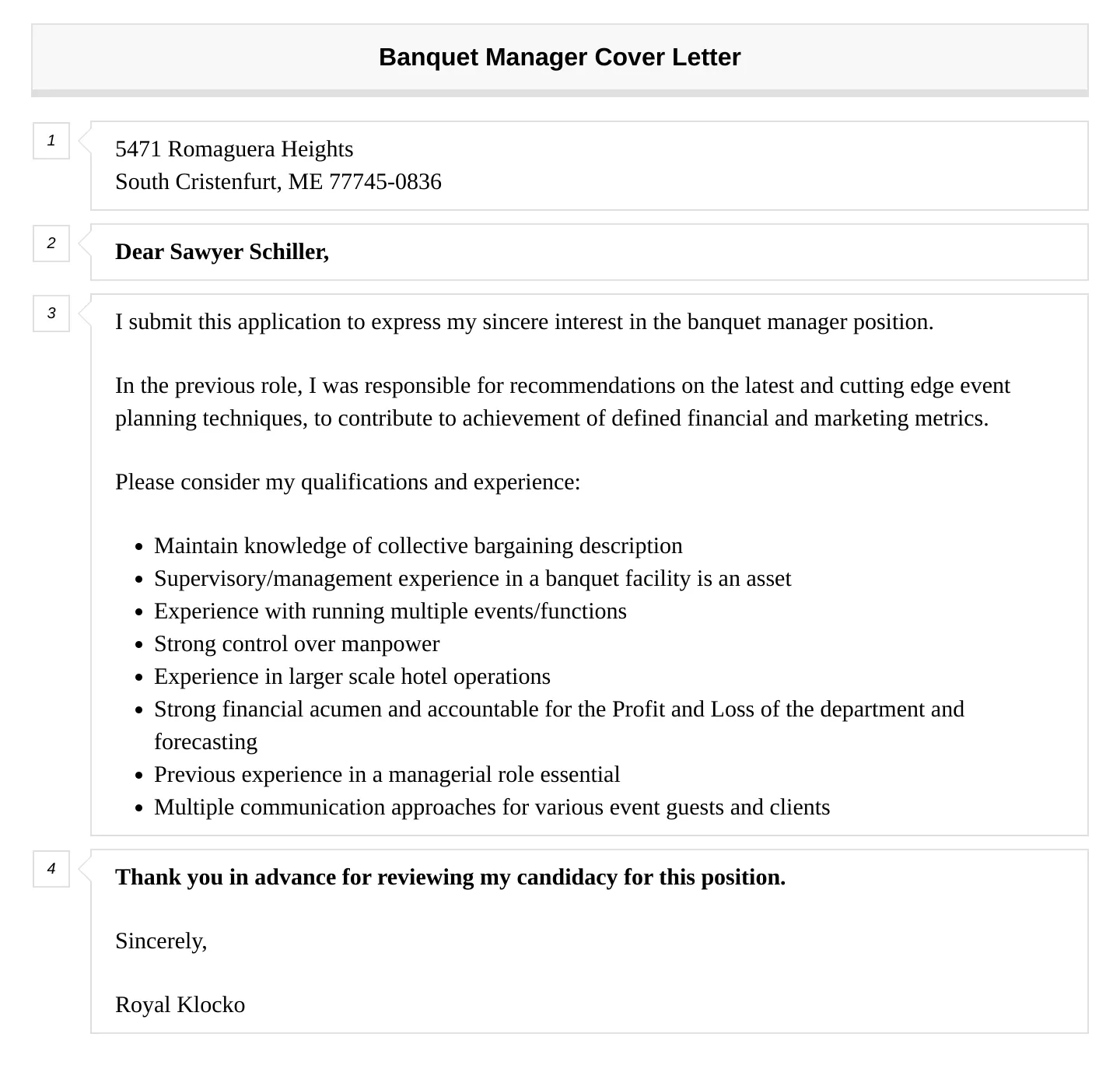
Before submitting your cover letter, proofread it meticulously for any grammatical errors, spelling mistakes, or typos. Ensure the formatting is consistent and professional. Use a clear, easy-to-read font and maintain consistent spacing. Use a spell checker, but don’t rely on it entirely. Read the letter aloud to catch any awkward phrasing or inconsistencies. Have a friend or colleague review it as well to get a fresh perspective. A well-formatted and error-free cover letter demonstrates your attention to detail and professionalism, leaving a positive impression on the hiring manager. Careful proofreading and formatting are critical for portraying you as a polished and capable candidate.
Formatting Your Cover Letter
Format your cover letter in a professional and easy-to-read style. Use a standard font like Times New Roman, Arial, or Calibri. Maintain a consistent font size (11 or 12 points) throughout the document. Use single spacing within paragraphs and double spacing between paragraphs. Left-align the text, and avoid using excessive bolding or italics. Keep the tone professional and positive. Use a business letter format, including your contact information, the date, the recipient’s contact information, a formal salutation (e.g., Dear Mr./Ms. [Last Name]), and a closing (e.g., Sincerely). Make sure your cover letter has a clear layout to promote readability. A well-formatted cover letter shows your attention to detail.
Review and Submission
Before submitting your cover letter and resume, take some time to review everything. Check for any inconsistencies. Make sure that your cover letter matches the job description and the company’s needs. Ensure that the contact information is correct. Submit both documents in the requested format (e.g., PDF). Send the cover letter and resume at the appropriate time. Following these steps will help you create a compelling cover letter that increases your chances of getting the job. Remember, a well-written cover letter can make a significant difference in the job application process. A successful application often starts with a good cover letter.
